- S.D. Eibar ready for maiden La Liga outing
- SD Eibar stengthen ahead of debut La Liga season
- Can ‘Super Mario’ live up to expectations in Madrid?
- MAN IN THE GROUND – Brentford 0 – 4 Osasuna
- Historic Basque derby welcomes S.D. Eibar to La Liga
- Munich to Madrid, via Brazil – Tony Kroos
- Rakitic in Spanish Switch
- Can Spain find redemption in Rio?
- Viva Espana! A season of redemption for Spanish football
- From the old to the new: who can fill the void in years to come for La Roja?
Can Portugal stop the greatest team in the world? Tactical Analysis and Preview
- Updated: 27 June, 2012


“The issue is not the system, but how you use the system“ Xabi Alonso.
Spain have progressed through the European Championships without displaying, to many observers at least, their best football. Their play has been characterised by slow, often ponderous passing, but with moments of sublime quality evident. Their rhythmic passing gradually wearing their opponent down, Pass, pass, pass. The ball goes left, it comes back again.
The ball goes right, it comes back again. And all the time the opponent is chasing, a state of perpetual motion as they shut off passing corridors which the Spanish are opening up. They follow Iniesta, Silva and Fabregas so Xavi goes backwards and finds Busquets. It’s a seemingly never ending challenge for the opponent. Press the Spanish, retain the shape, prevent options opening up and throughout, ensure that when you do gain possession, you possess an attacking threat. It’s relentless pressure.
Critics have begun labelling Spain as boring even when Andre Iniesta confirms: “Clearly football is more attractive when both teams try to win. Don’t forget this style changed Spanish history”
There is complete faith in the Spanish squad about the manner and style in which they are playing. The full backs push high up the pitch and provide the width as the inverted wingers cut in field and link with the central midfielders and the striker. The striker?
Spain have successfully implemented a false 9 system at this tournament, mirroring many aspects of the Barcelona system. Given the quantity of Barcelona players in the squad, it’s not a huge surprise.
Yet the inclusion of Fabregas as the false 9 in the Spanish line up has created the most controversy from a Spanish perspective to date. His inclusion at the expense of a striker, principally Fernando Torres, has helped fill numerous column inches and been used in conjunction with the boring tag to denigrate Spain. It’s become the stick with which to beat Spain yet it’s not even fully understood by many of those critics why del Bosque is making these changes to the system.
The discussion has focussed on the wrong issues. Journalists seem to be caught in some form of revisionist haze recalling the free flowing attacking Spain of 2008 and 2010. Whilst the team of 2008 was more attacking, Spain’s domination since then delivers increasingly defensive opponents. As opponents have adapted, so too have Spain.
At the heart of the decision to select Fabregas or Torres is not about who provides the better attacking option. The decision revolves around the issue of control and how Spain can gain that control, maintain it and exercise it over their opponent.
Cesc vs Torres – The Issue of Control
The chart above illustrates where Cesc and Torres received or attempted to receive passes against France in the quarter finals.
Whilst Cesc stays relatively deep in comparison to a conventional striker, Torres is moving towards the penalty area in most cases, operating off the shoulder of the last defender and always waiting for the through ball when he can utilise his pace.
Opponents of the false 9 system will point to this as further evidence of the need for a striker. Torres helped stretch the French defence and pushed them further back whereas Fabregas operated in front of the defence. Even if Torres is not performing well, his presence on the pitch forces defenders into a decision. If they push high, there is always the chance of Torres breaking free therefore, the opponent recognises this and defends deeper.
Whilst that is true, what is also important to note is the additional control which Fabregas offers. The introduction of Torres against France and a more vertical Spain resulted in possession dropping and a loss of control for a period in the match. Playing through balls to suit the natural game of Torres comes at a premium. Not all passes will be successful and the opposition then have the ball back and Spain need to press once more.
With the movement of Fabregas and his combination play, Spain dominate possession and tire the opponent out.
In the games against Italy, Croatia and France, del Bosque has made a change around the 60 minute mark, introducing pace and width to the side initially via Navas and now with Pedro.
Spain control the game, suffocating you with possession and when you are beginning to tire, they introduce an element of verticality to their play.
It’s becoming the del Bosque standard and allows the Spanish players to operate at a lower physical level during the match as they control the tempo. The players have greater recovery periods during the match whilst the opponents chase shadows. Spain rest when in possession. With greater control comes more possession. Spain can recover.. There are signs of tiredness now.
Many of the Spanish squad have played football incessantly now with little in the way of a summer break over the past 4 years.The fatigue is catching up. The false 9 system recognises this and helps address the problem.
Space Creation
“We like when other teams leave out their ball players. It’s good for us when others change their system. We never change ours.” Xavi Hernandez
Too often, teams are altering their system before playing Spain. Clearly, given the talent within the Spanish team, changes must be considered and implemented but a balance must be struck. You cannot change your team so drastically to tackle Spain that you negate your own attacking possibilities.
Against both Croatia and France, opposition substitutions have created space for Spain to attack. Croatia set out defensively but as they required a win to progress to the quarter final stage, Bilic was forced to make alterations as the game meandered towards a 0-0 stalemate. The final throw of the dice for Bilic was the removal of Vukojevic in the 81st minute. One change which immediately created new openings for Spain. The removal of Vukojevic allowed Fabregas space to move forward unopposed and play the pass which released Iniesta against Croatia. Navas subsequently walked the ball into the net.
Similarly, against France, Blanc was forced to make positive changes to his team as les bleus trailed 1-0. The removal of M’Vila after 79 minutes provided France with a new attacking threat in Giroud but it also created the space for Spain to function more efficiently. Santi Cazorla found time and space to pass forward to Pedro under no pressure. Why was there no pressure? M’Vila had been removed and France lacked any defensive midfield presence.
Teams set out defensive formations against Spain but the loss of a goal alters the paradigm of the match. The opposition coach must react, typically, by removing a defensive payer and replacing him with an attacking player. But so far this has not yielded results and only offered Spain more room to create attacks and ultimately, score goals.
“morir con las botas puestas“
Die with your boots on. At least possess the courage to have a go and if you suffer defeat, experience it on your own terms rather than abandoning your footballing principles for a defend at all costs mentality.
Continue to NEXT PAGE>>>
Follow @icentrocampista
One Comment
You must be logged in to post a comment Login







Pingback: Span v Portugal tactical preview | elcentrocampista.com – Spanish … « Spain Football News